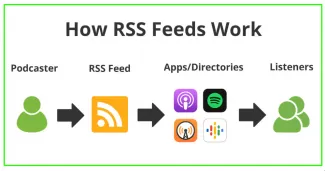RSS (Really Simple Syndication) feeds are a way for websites and blogs to distribute their content to a wide audience in a standardized format. An RSS feed is essentially an XML file containing a summary of a website's latest content, including headlines, descriptions, and links to full articles or posts. By subscribing to an RSS feed, users can stay up-to-date with the latest content from a website without having to visit it directly.
RSS feeds are especially useful for following a large number of websites or blogs, as they allow users to view new content in a single location, such as an RSS reader. This can save time and effort, as users don't have to manually check each website for updates.
RSS feeds can also be used by other websites and services, such as news aggregators and search engines, to display and distribute content. This helps to increase the visibility and reach of a website's content.
How do I subscribe RSS feed ?
To subscribe to an RSS feed, you will need an RSS reader. There are several different types of RSS readers available, including:
- Web-based readers: These are online services that allow you to subscribe to and view RSS feeds in a web browser. Examples include Feedly, Inoreader, and The Old Reader.
- Desktop readers: These are software programs that you can download and install on your computer. Examples include FeedDemon, Liferea, and Vienna.
- Mobile app readers: These are apps that you can download and use on your smartphone or tablet. Examples include Flipboard, Reeder, and gReader.
Once you have chosen and set up an RSS reader, you can subscribe to a feed by following these steps:
- Copy the RSS feed URL from the website or blog that you want to subscribe to.
- Open your RSS reader and look for the option to add a new feed, often represented by an "+" or "Subscribe" button.
- Paste the URL into the appropriate field and click on the "Add" or "Subscribe" button.
- The RSS reader will now automatically check the website for updates and display new content in your reader.
Note that different RSS readers may have slightly different steps for subscribing to feeds. If you're having trouble, consult the help documentation or support resources for the specific RSS reader you're using.
Here are a few examples of RSS feeds from popular websites and blogs:
- TosWebDeveloper Blog : https://toswebdeveloper.com/rss.xml
- CNN Breaking News: http://rss.cnn.com/rss/edition.rss
- The New York Times - Top Stories: http://rss.nytimes.com/services/xml/rss/nyt/HomePage.xml
- BBC News - World: http://feeds.bbci.co.uk/news/world/rss.xml
- TechCrunch - Latest News: https://techcrunch.com/feed/
- Huffington Post - Top News: https://www.huffpost.com/section/front-page/feed
These are just a few examples, but there are RSS feeds available for almost any website or blog that regularly publishes new content. To find the RSS feed for a specific website, look for an RSS icon, often represented by a small orange square with white radio waves, or look for a button or link labeled "RSS" or "Subscribe." Some websites also have a link for "subscribe to our RSS" or "subscribe to our newsletter"
Please note that not all websites or blogs have an RSS feed, so it's always best to check for the RSS icon or button on the website to be sure.


Comments